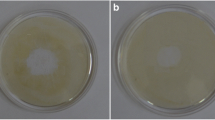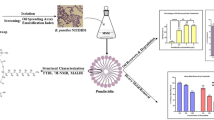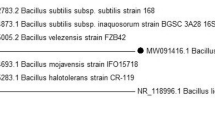Abstract
Bacillus tequilensis strain CH had been previously shown to produce a biosurfactant. In this study, chemical structure of the purified biosurfactant was determined by using high performance liquid chromatography and liquid chromatography-mass spectroscopy as a 10 amino acid cyclic lipopeptide (CL). The cyclic lipopeptide was found to be active against Anopheles culicifacies larvae with a LC50 of 110 µg/ml in 2 days. 1 ppm cadmium (Cd) which had a profound mutagenic effect on the cell division of onion (Allium cepa) root tip cell resulting in abnormal metaphase, abnormal anaphase and nuclei elongation was partially reversed in the presence of 0.1 mg/ml of CL (52% cells dividing normally and 8% with abnormal division) and was comparable to control experiment where no Cd was present. Thus, the CL described in this report may have applications in eliminating larvae from water repository systems and in reversing the effects of cadmium pollution.



Similar content being viewed by others
References
Das K, Mukherjee AK (2006) Assessment of mosquito larvicidal potency of cyclic lipopeptides produced by Bacillus subtilis strains. Acta Trop 97:168–173. https://doi.org/10.1016/j.actatropica.2005.10.002
de Faria AF, Teodoro-Martinez DS, de Oliveira Barbosa GN, Vaz BG, Silva ÍS, Garcia JS, Tótola MR, Eberlin MN, Grossman M, Alves OL, Durrant LR (2011) Production and structural characterization of surfactin (C14/Leu7) produced by Bacillus subtilis isolate LSFM-05 grown on raw glycerol from the biodiesel industry. Process Biochem 46(10):1951–1957
Fiskesjo G (1985) The Allium test as a standard in environmental monitoring. Hereditas 102:99–112. https://doi.org/10.1111/j.1601-5223.1985.tb00471.x
Geetha I, Manonmani AM (2010) Surfactin: a novel mosquitocidal biosurfactant produced by Bacillus subtilis ssp. subtilis (VCRC B471) and influence of abiotic factors on its pupicidal efficacy. Lett Appl Microbiol 51:406–412. https://doi.org/10.1111/j.1472-765X.2010.02912.x
Ghribi D, Chaabouni SE (2011) Enhancement of Bacillus subtilis lipopeptide biosurfactants production through optimization of medium composition and adequate control of aeration. Biotechnol Res Int 2011:653654–653656
Ghribi D, Elleuch M, Abdelkefi L, Ellouze-Chaabouni S (2012) Evaluation of larvicidal potency of Bacillus subtilis SPB1 biosurfactant against Ephestia kuehniella (Lepidoptera: Pyralidae) larvae and influence of abiotic factors on its insecticidal activity. J Stored Prod Res 48:68–72. https://doi.org/10.1016/j.jspr.2011.10.002
Juwarkar AA, Nair A, Dubey KV, Singh SK, Devotta S (2007) Biosurfactant technology for remediation of cadmium and lead contaminated soils. Chemosphere 68(10):1996–2002
Kaustuvmani P, Rupshikha P, Mohan CK, Suresh D (2017) Characterization of biosurfactant produced during degradation of hydrocarbons using crude oil as sole source of carbon. Front Microbiol 8:279
Kuiper I, Lagendijk LE, Pickford R, Derrick PJ, Lamers EMG, Lugtenberg JJB, Bloemberg VG (2004) Characterization of two Pseudomonas putida lipopeptide biosurfactants, putisolvin I and II, which inhibit biofilm formation and break down existing biofilms. Mol Microbiol 51:97–113
Liu D, Jiang WGX (2003) Effects of cadmium on root growth, cell division and nucleoli in root tip cells of garlic. Biol Plant 47:79. https://doi.org/10.1023/A:1027384932338
Manahan SE (2003) Toxicological chemistry and biochemistry, 3rd edn. CRC Press, Limited Liability Company (LLC), Boca Raton
Maoxue L (1989) Silver staining of plant chromosomes—techniques, principle and application. J Wuhan Bot Res 7:87–96
Mukherjee AK (2007) Potential application of cyclic lipopeptide biosurfactants produced by Bacillus subtilis strains in laundry detergent formulations. Lett Appl Microbiol 45(3):330–335
Nabar BM, Lokegaonkar S (2015) Larvicidal activity of microbial metabolites extracted from extremophiles against vector mosquitoes. Int J Mosq Res 2:161–165
Nielsen TH, Sorensen D, Tobiasen C, Andersen JB, Christophersen C, Givskov M, Sorensen J (2002) Antibiotic and biosurfactant properties of cyclic lipopeptides produced by fluorescent Pseudomonas spp. from the sugar beet rhizosphere. Appl Environ Microbiol 68:7 3416–3423
Panneerselvam C, Murugan K, Kovendan K et al (2013) Mosquito larvicidal and pupicidal activity of Euphorbia hirta Linn. (Family: Euphorbiaceae) and Bacillus sphaericus against Anopheles stephensi Liston. (Diptera: Culicidae). Asian Pac J Trop Med 6:102–109 doi: https://doi.org/10.1016/S1995-7645(13)60003-6
Prabhukumar G, Matsumoto M, Mulchandani A, Chen W (2004) Cadmium removal from contaminated soil by tunable biopolymers. Environ Sci Technol 38(11):3148–3152
Pradhan AK, Pradhan N, Mall G et al (2013) Application of lipopeptide biosurfactant isolated from a halophile: Bacillus tequilensis CH for inhibition of biofilm. Appl Biochem Biotechnol 171:1362–1375. https://doi.org/10.1007/s12010-013-0428-3
Pradhan AK, Pradhan N, Mohapatra P et al (2014a) Cytotoxic effect of microbial biosurfactants against human embryonic kidney cancerous cell: HEK-293 and their possible role in apoptosis. Appl Biochem Biotechnol 174:1850–1858. https://doi.org/10.1007/s12010-014-1168-8
Pradhan AK, Pradhan N, Sukla LB et al (2014b) Inhibition of pathogenic bacterial biofilm by biosurfactant produced by Lysinibacillus fusiformis S9. Bioprocess Biosyst Eng 37:139–149. https://doi.org/10.1007/s00449-013-0976-5
Priya T, Usharani G (2009) Comparative study for biosurfactant production by usng Bacillus subtilis and Pseudomonas aeruginosa. Bot Res Int 2:284–287
Priyadarshini E, Pradhan N, Pradhan AK, Pradhan P (2016) Label free and high specific detection of mercury ions based on silver nano-liposome. Spectrochim Acta Part A Mol Biomol Spectrosc 163:127–133. https://doi.org/10.1016/j.saa.2016.03.040
Saravanan V, Vijayakumar S (2012) Isolation and screening of biosurfactant producing microorganisms from oil contaminated soil. J Acad Ind Res 1:264–268
Tran H, Kruijt M, Raaijmakers JM (2008) Diversity and activity of biosurfactant-producing Pseudomonas in the rhizosphere of black pepper in Vietnam. J Appl Microbiol 104:839–851
Weggler K, McLaughlin MJ, Graham RD (2004) Effect of Chloride in soil solution on the plant availability of biosolid-borne cadmium. J Environ Qual 33:496–504
Wen J, Stacey SP, McLaughlin MJ, Kirby JK (2009) Biodegradation of rhamnolipid, EDTA and citric acid in cadmium and zinc contaminated soils. Soil Biol Biochem 41:2214–2221. https://doi.org/10.1016/j.soilbio.2009.08.006
Wuana RA, Okieimen FE (2011) Heavy metals in contaminated soils: a review of sources, chemistry, risks and best available strategies for remediation. ISRN Ecol 2011: 20
Acknowledgements
The authors intend to show a deep sense of gratitude to the Honourable President Dr. Manoj Nayak, Siksha ‘O’ Anusandhan, Deemed to be University for permitting to publish scientific literature. The authors also thank Regional Centre for Medical Research, and CSIR-IMMT, Odisha for providing scientific support.
Author information
Authors and Affiliations
Corresponding author
Ethics declarations
Conflict of interest
No conflict of interest.
Rights and permissions
About this article
Cite this article
Pradhan, A.K., Rath, A., Pradhan, N. et al. Cyclic lipopeptide biosurfactant from Bacillus tequilensis exhibits multifarious activity. 3 Biotech 8, 261 (2018). https://doi.org/10.1007/s13205-018-1288-x
Received:
Accepted:
Published:
DOI: https://doi.org/10.1007/s13205-018-1288-x




